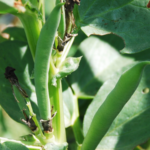Have you ever seen thorny plants resembling watermelons growing wild on roadsides or in your garden and wondered what they could be? Do watermelon plants have thorns?
Watermelon plants do not have thorns. However, the weed Solanum rostratum (or buffalo bur, as it is commonly called) has leaves similar to those of watermelon plants. Buffalo bur does have thorns, so you’re most likely dealing with buffalo bur instead of watermelon.
Keep reading to learn more about buffalo bur and how you can keep it from taking over your garden.
Do I Have A Watermelon Or Buffalo Bur Plant?
Even though buffalo bur plants look quite similar to watermelon plants, their appearances are the only thing they have in common. While watermelon plants grow beautiful, tasty fruits, buffalo bur just grows thousands of painful, spiky thorns.
This makes telling the difference between a watermelon and buffalo bur plant quite simple. If the plant in question has any thorns at all, it’s definitely not watermelon and is most likely buffalo bur.
What Is Buffalo Bur?
Now that you know you’re dealing with buffalo bur instead of watermelon, it’s helpful to know what this weed is and why it’s such a nuisance. Buffalo bur belongs to the nightshade family, just like potatoes and tomatoes.
All members of the nightshade family contain alkaloids, which are toxic in high enough quantities. But unlike other members of the nightshade family that also produce edible fruits, all parts of the buffalo bur plant are toxic to animals and humans.
Buffalo bur plants grow many sharp thorns that can inflict incredible pain. Even newly sprouted buffalo bur plants have thorns, making handling the plant very difficult no matter how old it is.
How Can I Get Rid Of Buffalo Bur?
Even though buffalo bur is painful to touch, there are several effective ways to kill it and keep it from taking over your yard or garden.
- Manually pull out or dig up each plant. While this method requires manual labor and thick gloves, it is by far the most effective. Removing each plant individually before it goes to seed will guarantee that no plants will return the next year.
- Regularly mow or weed whack the plants. Buffalo bur plants are only spread by seed, which means you can keep them from reproducing by cutting off any new growth before seeds form. This method is slower than manually removing the plants, but it will eventually kill them by depleting the plants’ energy supply.
- Apply chemical herbicides. Herbicides containing glyphosate and/or 2,4-D (such as Roundup) can very effectively kill buffalo bur plants, but they will also kill anything else growing nearby. Exercise caution when applying this method to protect any plants you want to keep.
Final Thoughts
If you’ve found a thorny, watermelon-looking plant in your yard, you’re most likely actually dealing with buffalo bur. This noxious weed produces incredibly painful thorns that will leave your skin burning for hours.
Thankfully, though, there are simple methods to remove buffalo bur plants from your yard. Manually removing each plant, cutting off new growth before seeds form, and applying chemical herbicides are all effective at keeping buffalo bur from taking over your property.



